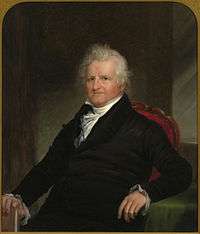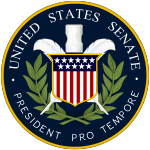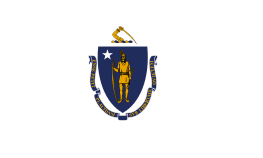Joseph Bradley Varnum
| Joseph Bradley Varnum | |
|---|---|
 | |
| 26th President pro tempore of the United States Senate | |
|
In office December 6, 1813 – February 3, 1814 | |
| President | James Madison |
| Preceded by | William H. Crawford |
| Succeeded by | John Gaillard |
| 6th Speaker of the United States House of Representatives | |
|
In office October 26, 1807 – March 3, 1811 | |
| President |
Thomas Jefferson James Madison |
| Preceded by | Nathaniel Macon |
| Succeeded by | Henry Clay |
| United States Senator from Massachusetts | |
|
In office June 29, 1811 – March 3, 1817 | |
| Preceded by | Timothy Pickering |
| Succeeded by | Harrison Gray Otis |
| Member of the U.S. House of Representatives from Massachusetts's 4th district | |
|
In office March 4, 1803 – June 29, 1811 | |
| Preceded by | Seth Hastings |
| Succeeded by | William M. Richardson |
| Member of the U.S. House of Representatives from Massachusetts's 9th district | |
|
In office March 4, 1795 – March 3, 1803 | |
| Preceded by | inaugural holder |
| Succeeded by | Phanuel Bishop |
| Member of the Massachusetts Senate | |
|
In office 1789-1795 | |
| Personal details | |
| Born |
January 29, 1751 Dracut, Massachusetts |
| Died |
September 21, 1821 (aged 70) Dracut, Massachusetts |
| Resting place | Vernum Cemetery, Dracut |
| Political party | Democratic-Republican |
| Children | 12 |
| Military service | |
| Service/branch | Massachusetts Militia |
| Battles/wars | American Revolutionary War |
Joseph Bradley Varnum (January 29, 1751 – September 21, 1821) was a U.S. politician of the Democratic-Republican Party from Massachusetts.
Biography
Joseph Bradley Varnum was born in Dracut, Massachusetts, Middlesex County, January 29, 1750 or 1751, a farmer with little formal education.
At the age of eighteen, he was commissioned captain by the committee of Massachusetts Bay Colony, and in 1787 colonel by the Commonwealth of Massachusetts. He was made brigadier general in 1802, and in 1805 major general of the state militia, holding the latter office at his death in 1821. After serving in the Massachusetts militia during the American Revolutionary War, Varnum helped to destroy the Shays insurrection before he was elected to the Massachusetts House of Representatives (1780–1785) and then the Massachusetts State Senate (1786–1795). He also served as a Justice of the Massachusetts Court of Common Pleas and as Chief Justice of the Massachusetts Court of General Sessions.
In 1794, Varnum was elected to the U.S. House of Representatives, where he served from March 4, 1795 until his resignation on June 29, 1811. During his last four years in the House, he served as its Speaker.
Varnum was elected to the U.S. Senate in 1811 to fill the vacancy in the term. June 29, 1811 to March 3, 1817; served as President pro tempore of the Senate during the Thirteenth Congress; chairman, Committee on Militia (Fourteenth Congress); after returning to Massachusetts in 1817, he again served in the Massachusetts State Senate, until his death September 21, 1821.
Varnum died in Dracut, and his body is interred in Varnum Cemetery.[1] His brother was James Mitchell Varnum.
Slavery
Henry Wilson, in his History of Slavery, quotes Varnum in the debate on the bill for the government of the Mississippi Territory before the United States House of Representatives in March 1798 as having been very strong and outspoken in his opposition to Negro servitude.
On March 3, 1805, Varnum submitted a Massachusetts Proposition to amend the Constitution[note 1] and Abolish the Slave Trade. This proposition was tabled until 1807, when under Varnum's leadership the amendment moved through Congress and passed both houses on March 2, 1807. President Thomas Jefferson signed it into law on March 3, 1807.[note 2]
Notes
- ↑ In the 1786 US Constitution there was a provision in Article I – the part of the document dealing with the duties of the legislative branch: Section 9. The migration or importation of such persons as any of the states now existing shall think proper to admit, shall not be prohibited by the Congress prior to the year one thousand eight hundred and eight, but a tax or duty may be imposed on such importation, not exceeding ten dollars for each person. In other words, the government could not ban the importation of slaves for 20 years after the adoption of the Constitution. And as the designated year 1808 approached, those opposed to slavery began making plans for legislation that would outlaw the trans-Atlantic slave trade.
- ↑ Journal of the House of Representatives of the United States 1804–1807 March 3, 1805 Congressman Joseph Bradley Varnum, one of the members for the State of Massachusetts, presented to the House a letter from the Governor of the said State, enclosing an attested copy of two concurrent resolutions of the Senate and House of Representatives of the State of Massachusetts, passed the fifteenth of February, in the present year, "instructing the Senators, and requesting the Representatives in Congress, from the said State, to take all legal and necessary steps, to use their utmost exertions, as soon as the same is practicable, to obtain an amendment to the Federal Constitution, so as to authorize and empower the Congress of the United States to pass a law, whenever they may deem it expedient, to prevent the further importation of slaves from any of the West India Islands, from the coast of Africa, or elsewhere, into the United States, or any part thereof:" Whereupon, A motion was made and seconded that the House do come to the following resolution: Resolved by the Senate and House of Representatives of the United States of America in Congress assembled, two-thirds of both Houses concurring, That the following article be proposed to the Legislatures of the several States, as an amendment to the Constitution of the United States, which, when ratified by three-fourths of the said Legislatures, shall be valid to all intents and purposes, as a part of the said Constitution, to wit: "That the Congress of the United States shall have power to prevent the further importation of slaves into the United States and the Territories thereof." The said proposed resolution was read, and ordered to lie on the table.
References
External links
- Varnum, Joseph. “Autobiography of General Joseph B. Varnum.” Edited by James M. Varnum. Magazine of American History 20 (November 1888): 405–14.
- United States Congress. "Joseph Bradley Varnum (id: V000074)". Biographical Directory of the United States Congress.
Attribution:
 This article incorporates text from a publication now in the public domain: "Varnum, James Mitchel". Appletons' Cyclopædia of American Biography. 1889.
This article incorporates text from a publication now in the public domain: "Varnum, James Mitchel". Appletons' Cyclopædia of American Biography. 1889.
| United States House of Representatives | ||
|---|---|---|
| Preceded by none-new position |
Member of the U.S. House of Representatives from Massachusetts's 9th congressional district March 4, 1795 – March 3, 1803 |
Succeeded by Phanuel Bishop |
| Preceded by Seth Hastings |
Member of the U.S. House of Representatives from Massachusetts's 4th congressional district March 4, 1803 – June 29, 1811 |
Succeeded by William M. Richardson |
| Preceded by Nathaniel Macon |
Speaker of the United States House of Representatives October 26, 1807 – March 4, 1809 May 22, 1809 – March 3, 1811 |
Succeeded by Henry Clay |
| United States Senate | ||
| Preceded by Timothy Pickering |
U.S. Senator (Class 2) from Massachusetts June 29, 1811 – March 3, 1817 Served alongside: James Lloyd, Christopher Gore, Eli P. Ashmun |
Succeeded by Harrison Gray Otis |
| Preceded by William H. Crawford |
President pro tempore of the United States Senate December 6, 1813 – February 3, 1814 |
Succeeded by John Gaillard |




